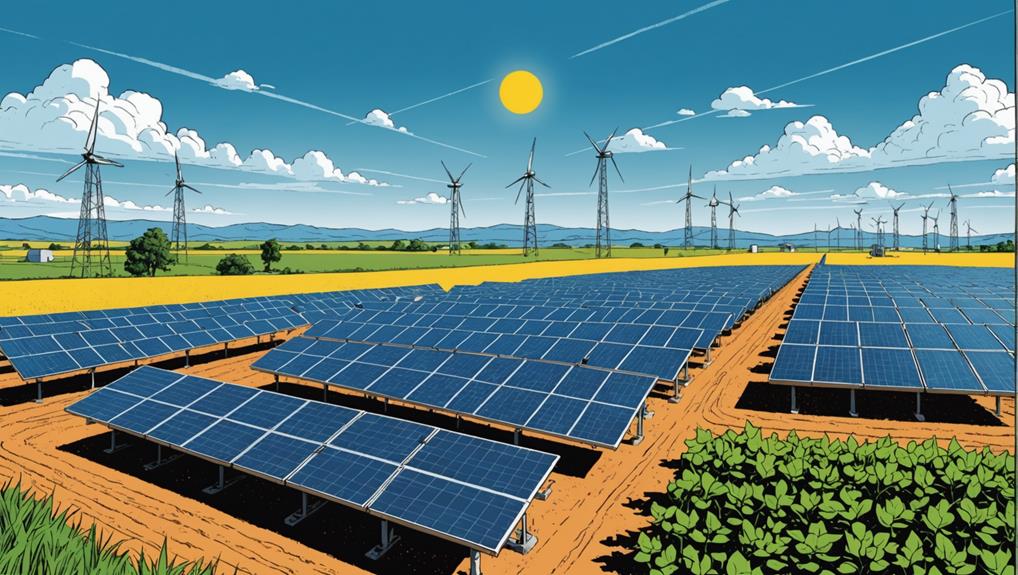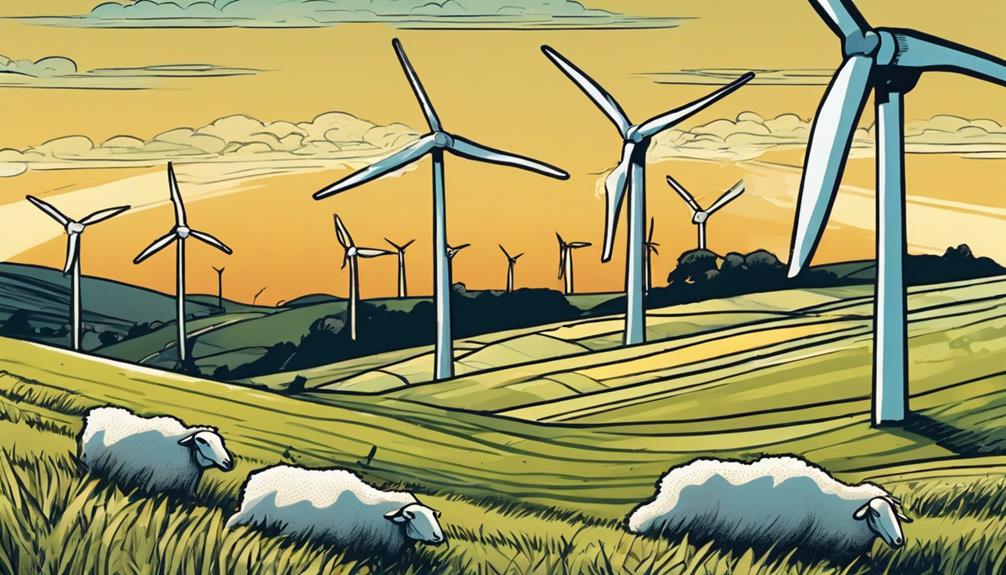To maximize your solar farm ROI, invest in top-quality panels with warranties and address any roofing issues beforehand. Optimize system size based on your building's needs and leverage incentives like Federal Solar Energy Credits. Stay informed on market changes, choose the right investment strategies, and use financial models effectively. Enhance efficiency by upgrading to advanced equipment and integrating battery storage. Regular maintenance and embracing new technologies are essential for long-term success. Remember, a strategic approach combining quality, efficiency, and financial know-how leads to better returns.
Key Takeaways
- Invest in quality panels for higher ROI.
- Optimize system size based on energy use.
- Stay updated on incentives and regulations.
- Utilize financial models for viability.
- Maximize efficiency with proper maintenance.
Solar Farm ROI Optimization
To optimize the ROI of a solar farm, focus on proper installation and maintenance to maximize long-term returns. When it comes to solar panel installations, making sure that the setup is done accurately can greatly impact the overall performance and profitability of the solar farm.
By investing in quality solar panels from reputable companies with warranties and coverage terms, you're setting yourself up for a higher ROI in the long run. It's also vital to address any roofing issues before installation to avoid costly repairs down the line, ultimately optimizing your ROI in solar energy projects.
Moreover, factors like system size optimization based on building size, energy use, and climate play an important role in enhancing long-term returns on investment. By understanding incentives such as Federal Solar Energy Credits, net metering, and state-specific programs, you can further maximize your financial gains and ROI in solar energy projects.
Solar Farm Investment Strategies

Solar farm investment strategies involve evaluating various factors such as location, pricing, incentives, and risk evaluation to optimize returns and profitability. To make informed decisions, staying updated on regulatory changes and market dynamics is essential.
Different investment options like direct funding, SRECs, investment funds, stocks, and portfolios offer diverse ways to enter the solar farm market. Utilizing financial models and templates can aid in evaluating the financial viability and profitability of solar projects effectively. These tools provide a thorough analysis of the potential returns and risks associated with solar farm investments.
Maximizing Solar Energy Returns

By optimizing installation methods and consistently maintaining your solar energy system, you can greatly increase your returns over its lifespan. Proper installation, regular maintenance, and system optimization are key factors in maximizing solar panel efficiency and ensuring a high return on investment (ROI) over the typical 25-30 year lifespan of solar panels.
Investing in quality solar panels and working with reputable installation companies can contribute significantly to long-term performance and increased financial gains. Additionally, understanding available incentives such as Tax Credits and programs is essential for maximizing the financial benefits of your solar energy investment.
Net metering, which allows excess energy to be credited back to the grid, can further enhance cost savings and overall ROI. In addition, solar energy installations have the added benefit of increasing property value through energy savings and environmental benefits, providing an additional boost to your returns.
Enhancing Solar Farm Efficiency

Enhance the effectiveness of your solar farm by optimizing panel tilt, orientation, and spacing to maximize year-round solar capture.
Upgrading to advanced solar panels, inverters, mounting structures, and transformers directly impacts effectiveness.
Integrating Battery Energy Storage Systems (BESS) stabilizes grids, enabling the sale of excess energy and boosting overall effectiveness.
Regular maintenance, technology upgrades, and embracing new solar technologies are essential for maximizing effectiveness and return on investment in solar projects.
Tools like RatedPower aid in project design, financial analysis, and energy generation forecasting, enhancing the effectiveness and success of solar farm projects.
Financial Models for Solar Projects
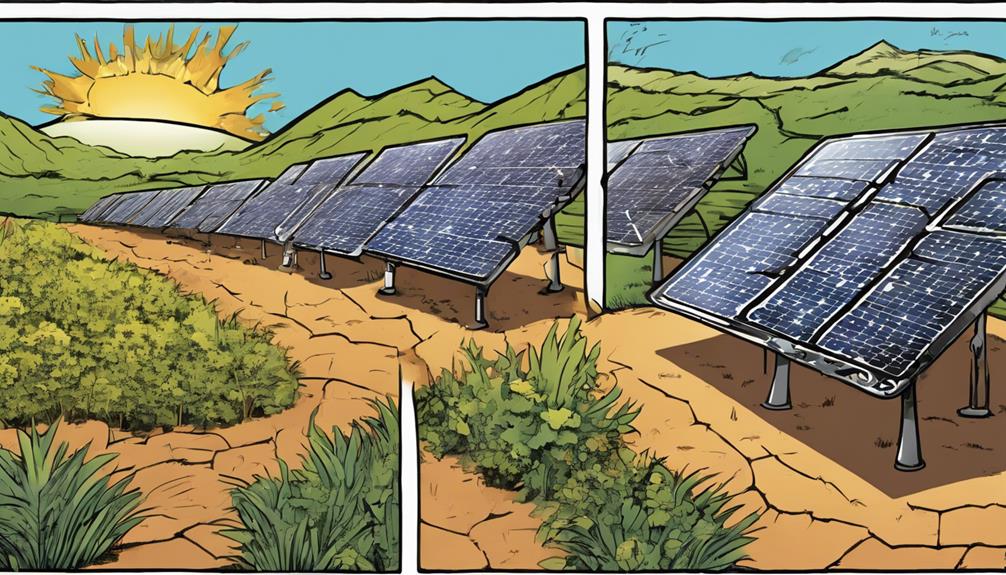
Optimize your solar project's financial success by leveraging advanced tools and models tailored for project finance, feasibility evaluation, and profitability analysis.
Financial models for solar projects offer detailed templates covering various aspects such as solar plant feasibility, project finance, renewable energy financial models, and green hydrogen production. These tools are essential for understanding market dynamics and technological advancements crucial for successful solar investments.
By utilizing advanced financial modeling tools, solar investment opportunities and future trends can be analyzed and predicted, aiding investors in making informed decisions.
Financial models play a pivotal role in evaluating the financial viability of solar projects and renewable energy ventures. They provide valuable insights into the profitability and feasibility of such ventures, enabling investors to navigate the complexities of the renewable energy market with confidence and precision.
Leveraging these models is key to maximizing returns and ensuring the long-term success of your solar project.
Solar Energy Market Dynamics
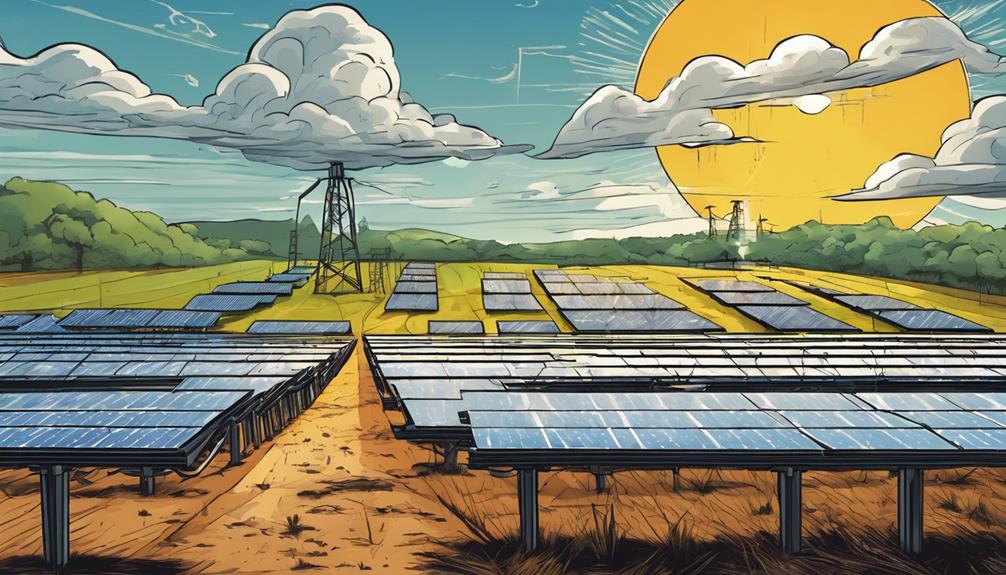
Understanding the ever-changing dynamics of the solar energy market is essential for successful investment decisions and maneuvering through the complexities of renewable energy ventures.
With countries worldwide experiencing a surge in solar farm growth and the increasing adoption of clean energy solutions, the solar energy market presents ample opportunities for investors seeking promising returns.
Market volatility, regulatory changes, and technological advancements have a significant impact on solar investments, making it vital to stay informed about incentive programs, subsidies, and market dynamics to devise successful solar investing strategies.
Policy shifts, market dynamics, and technological advancements play pivotal roles in shaping the solar energy market landscape, influencing the profitability and sustainability of solar farms.
To navigate the intricate web of Solar Investment, keeping abreast of energy production trends, market fluctuations, and industry developments is key to making informed decisions and maximizing returns in the dynamic solar energy market.
Environmental Considerations for Solar Farms
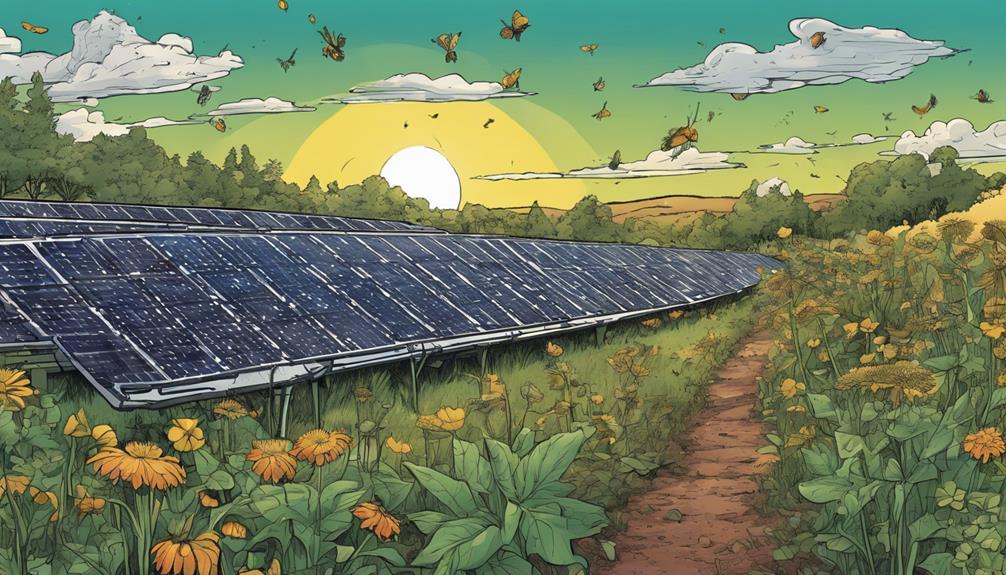
Considering the environmental impact of solar farms involves identifying suitable land areas and implementing measures to mitigate effects on wildlife. When it comes to solar farm development, environmental considerations are critical for long-term sustainability and community acceptance.
Here are some key factors to keep in mind:
- Conduct thorough environmental impact assessments to understand the implications of solar farm installations on ecosystems and biodiversity.
- Engage with stakeholders, including local communities, environmental organizations, and regulatory bodies, to address concerns and incorporate feedback into project planning.
- Implement wildlife-friendly practices such as habitat restoration, fencing, and monitoring to minimize disruptions to local fauna.
- Prioritize land use planning to avoid environmentally sensitive areas and preserve natural habitats.
- Embrace a culture of environmental stewardship through ongoing maintenance and technology upgrades to enhance the ecological value of solar farms.
Emerging Solar Technologies
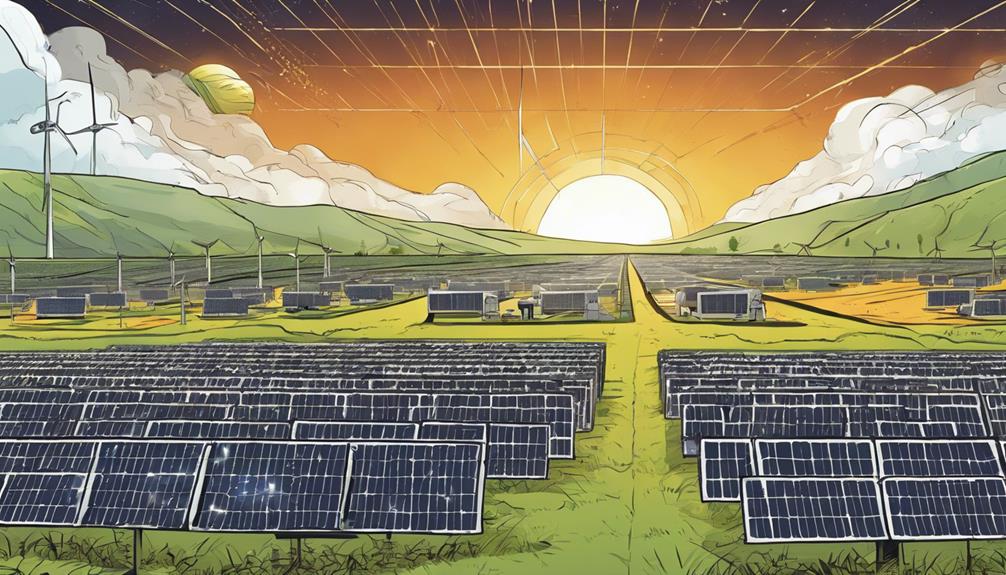
Perovskite solar cells, known for their high efficiency and low production costs, are revolutionizing the future of solar farm installations. These new solar technologies are enhancing the performance and profitability of commercial solar PV systems.
Bifacial panels, capable of capturing sunlight from both sides, can boost energy generation by up to 27%, notably improving the return on investment (ROI) for solar farms. Additionally, integrating energy storage solutions like lithium-ion batteries optimizes operations by storing excess energy for later use, maximizing the overall ROI.
Continuous advancements in solar technology are driving efficiency improvements, making solar farms more cost-effective and attractive for investors seeking higher returns. The focus on emerging solar technologies lies in enhancing energy production, reducing maintenance costs, and increasing the overall profitability of solar farm investments.
Incorporating these new solar technologies into solar farm projects can lead to greater efficiency, reliability, and financial gains in the evolving landscape of renewable energy.
Future Trends in Solar Investing
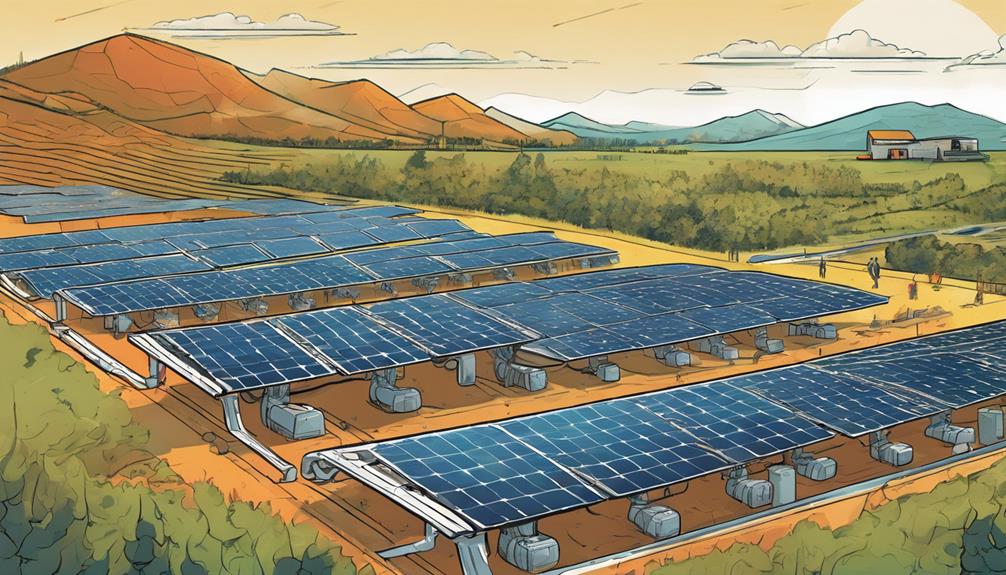
Investors in the solar energy sector are increasingly focusing on future trends to maximize returns and capitalize on evolving market dynamics. As you navigate the landscape of solar investing, keep an eye on these key trends:
- Solar Energy Expansion in Urban Areas: The shift towards solar installations in urban settings presents new opportunities for investors to tap into high-demand markets and maximize energy generation potential.
- Integration of Advanced Financial Model Templates: Leveraging sophisticated financial model templates can streamline project evaluation, enhance decision-making processes, and optimize ROI calculations in the solar energy sector.
- Technological Advancements Driving Efficiency: Stay updated on the latest technological innovations, such as perovskite solar cells and energy storage solutions, to boost efficiency and stay competitive in the market.
- Sustainable Growth Opportunities: The continuous evolution of solar technologies offers sustainable growth prospects for investors seeking long-term viability and environmental impact.
- Diversification Strategies for Enhanced Returns: Exploring diverse solar investment opportunities and strategies can help mitigate risks and capture value across different segments of the solar energy market.
Frequently Asked Questions
What Is the Average ROI for a Solar Farm?
For a solar farm, the average ROI typically ranges from 5-10%, influenced by location, technology, and financing. Factors like installation costs, energy efficiency, maintenance, and incentives impact ROI. Long-term trends and regulations also play a role.
How Long Does It Take for a Solar Farm to Be Profitable?
It usually takes 5-7 years for a solar farm to become profitable. Factors like initial investment, energy efficiency, and operating costs influence profitability. Incentives, tax credits, and proper maintenance play essential roles in accelerating profitability.
Is a 10 Acre Solar Farm Profitable?
Yes, a 10-acre solar farm can be profitable! Generating up to 2-3 megawatts and earning $500,000 to $1 million annually, with initial costs of $1.5 to $3 million, your investment can pay off in 7 to 12 years.
What Is a Good ROI for Solar?
For solar, a good ROI typically ranges from 10% to 20% annually. Factors like location, system size, and financing play a role. To optimize ROI, choose quality components, maximize energy production, and leverage incentives.
What are the Best Practices and Advancements in Solar Farm ROI and Construction?
When it comes to maximizing solar farm ROI, following the latest solar farm construction best practices is crucial. From utilizing the most efficient solar panels to optimizing land use, advancements in construction techniques are key. By staying up to date with industry developments, solar farms can achieve higher returns on investment.
Conclusion
As you navigate the complex landscape of solar farm ROI, remember that success lies in balancing financial strategies with environmental considerations.
By staying informed on the latest advancements in solar technology and market dynamics, you can maximize your returns while minimizing your impact on the planet.
Embrace the future trends in solar investing and continue to push the boundaries of efficiency and sustainability.
The future of solar energy is bright, and it's up to you to seize the opportunities it offers.
